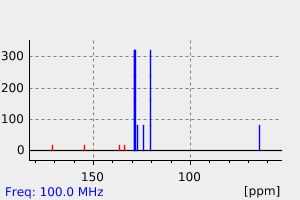1,5-diphenylhydantoin | 15900-37-5
中文名称
——
中文别名
——
英文名称
1,5-diphenylhydantoin
英文别名
1,5-diphenyl-imidazolidine-2,4-dione;1,5-Diphenyl-imidazolidin-2,4-dion;3,4-Diphenylimidazolidine-2,5-dione;1,5-diphenylimidazolidine-2,4-dione
CAS
15900-37-5
化学式
C15H12N2O2
mdl
——
分子量
252.272
InChiKey
BDGMEPAZTWBSPP-UHFFFAOYSA-N
BEILSTEIN
——
EINECS
——
-
物化性质
-
计算性质
-
ADMET
-
安全信息
-
SDS
-
制备方法与用途
-
上下游信息
-
文献信息
-
表征谱图
-
同类化合物
-
相关功能分类
-
相关结构分类
物化性质
-
熔点:189-190 °C
-
密度:1.279±0.06 g/cm3(Predicted)
计算性质
-
辛醇/水分配系数(LogP):2.4
-
重原子数:19
-
可旋转键数:2
-
环数:3.0
-
sp3杂化的碳原子比例:0.07
-
拓扑面积:49.4
-
氢给体数:1
-
氢受体数:2
上下游信息
反应信息
-
作为反应物:描述:1,5-diphenylhydantoin 在 potassium dichromate 、 溶剂黄146 作用下, 生成 5-hydroxy-1,5-diphenylimidazoline-2,4-dione参考文献:名称:Holmberg, Acta Chemica Scandinavica (1947), 1950, vol. 4, p. 821,823, 824, 825摘要:DOI:
-
作为产物:描述:alkaline earth salt of/the/ methylsulfuric acid 在 苯胺 作用下, 生成 1,5-diphenylhydantoin参考文献:名称:Aspelund, Acta Academiae Aboensis, Series B: Mathematica et Physica, 1939, vol. 12, # 5, p. 23摘要:DOI:
文献信息
-
Microwave Assisted Synthesis of 1,5-Disubstituted Hydantoins and Thiohydantoins in Solvent-Free Conditions作者:Satya Paul、Mukta Gupta、Rajive Gupta、André LoupyDOI:10.1055/s-2002-19308日期:——1,5-Disubstituted hydantoins/thiohydantoins 3a-p have been synthesized in 8l-95% yield by a microwave-promoted solvent-free condensation of arylglyoxals 1 and phenylurea/thiourea 2 using PPE as a reaction mediator. This method can be extended towards the parallel synthesis of 3. The workup is simple and involves treatment with ice-cold water.
-
Synthesis and Activity of 1,3,5-Triphenylimidazolidine-2,4-diones and 1,3,5-Triphenyl-2-thioxoimidazolidin-4-ones: Characterization of New CB<sub>1</sub> Cannabinoid Receptor Inverse Agonists/Antagonists作者:Giulio G. Muccioli、Johan Wouters、Caroline Charlier、Gerhard K. E. Scriba、Teresa Pizza、Pierluigi Di Pace、Paolo De Martino、Wolfgang Poppitz、Jacques H. Poupaert、Didier M. LambertDOI:10.1021/jm050484f日期:2006.2.1affinity and selectivity for the human CB(1) cannabinoid receptor. A [(35)S]-GTPgammaS binding assay revealed the inverse agonist properties of the compounds at the CB(1) cannabinoid receptor. Furthermore, molecular modeling studies were conducted in order to delineate the binding mode of this series of derivatives into the CB(1) cannabinoid receptor. 1,3-Bis(4-bromophenyl)-5-phenylimidazolidine-2,4-dione肥胖和代谢综合症以及药物依赖性(尼古丁,酒精,阿片类药物)是CB(1)大麻素受体拮抗剂和反向激动剂的两个主要治疗应用。在本研究中,我们报告了1,5-二苯基咪唑烷-2,4-二酮和1,3,5-三苯基咪唑烷-2,4-二酮衍生物的合成和结构亲和性关系。这些新的1,3,5-三苯基咪唑烷-2,4-二酮衍生物及其硫代等排物是通过原始途径获得的,并且对人CB(1)大麻素受体表现出令人感兴趣的亲和力和选择性。[[(35)S] -GTPgammaS结合测定揭示了化合物在CB(1)大麻素受体上的反向激动剂特性。此外,进行分子建模研究以描绘该系列衍生物到CB(1)大麻素受体的结合模式。1,3-双(4-溴苯基)-5-苯基咪唑烷-2,4-二酮(25)和1,3-双(4-氯苯基)-5-苯基咪唑烷-2,4-二酮(23)是咪唑烷迄今为止,对人CB(1)大麻素受体具有最高亲和力的-2,4-二酮衍生物。
-
Nonprostanoid prostacyclin mimetics. 3. Structural variations of the diphenyl heterocycle moiety作者:Nicholas A. Meanwell、Michael J. Rosenfeld、Ashok K. Trehan、Jeffrey L. Romine、J. J. Kim Wright、Catherine L. Brassard、John O. Buchanan、Marianne E. Federici、J. Stuart Fleming、Marianne Gamberdella、George B. Zavoico、Steven M. SeilerDOI:10.1021/jm00097a007日期:1992.94,5-Diphenyl-2-oxazolenonanoic acid (2) and 2-[3-[2-(4,5-diphenyl-2-oxazolyl)ethyl]phenoxy]acetic acid (3) were previously identified as nonprostanoid prostacyclin (PGI2) mimetics that inhibit ADP-induced aggregation of human platelets in vitro. The effects on biological activity of substitution and structural modification of the 4- and 5-phenyl rings of 3 was examined. Potency showed a marked sensitivity4,5-二苯基-2-恶唑壬酸(2)和2- [3- [2-(4,5-二苯基-2-恶唑基)乙基]苯氧基]乙酸(3)先前被确定为非前列腺素前列环素(PGI2 )在体外抑制ADP诱导的人类血小板聚集的模拟物。考察了3的4-和5-苯基环对取代和结构修饰的生物活性的影响。效能显示出对将取代基引入这些芳族环的显着敏感性,并且只有双-4-甲基衍生物9j(IC50 = 0.34 microM)与母体结构3(IC50 = 1.2 microM)相比具有增强的效能。在苯环的邻位或间位取代,被噻吩基或环己基部分取代,或限制在平面菲系统中产生的化合物不是ADP诱导的血小板聚集的有效抑制剂。相比之下,杂环部分的变化表明,SAR的严格性要低得多,并且发现许多5和6元杂环可有效替代2和3的恶唑环。二苯甲基部分可作为4,5-的有效等排体自13aad以来的二苯环杂环化合物显示出与3相似的血小板抑制活性。除了3,4,5-三苯基吡唑衍生物13g以外,与类似取代的3
-
Imidazolidine carboxylic acids and esters as blood platelet aggregation申请人:Bristol-Myers Squibb Company公开号:US04970225A1公开(公告)日:1990-11-13Heterocyclic acids and esters useful as inhibitors of mammalian blood platelet aggregation characterized by Formula I are disclosed. HET.sub.1 -(CH.sub.2).sub.n CO.sub.2 R (I) Formula I compounds are those wherein n is 6-9, R is hydrogen, lower alkyl or an alkali metal ion, and HET.sub.1 is the heterocyclic radical 2,5-dioxo-3,4-diphenylimidazolidin-1-yl.
-
Hydantoin derivatives, their preparation and pharmaceutical compositions containing them申请人:NIPPON ZOKI PHARMACEUTICAL CO. LTD.公开号:EP0006407A1公开(公告)日:1980-01-09Hydantoin derivatives, of formula: a process for the preparation thereof and pharmaceutical compositions containing the derivatives as active ingredients, particularly remedies for treatment of dieseases caused by stress.
表征谱图
-
氢谱1HNMR
-
质谱MS
-
碳谱13CNMR
-
红外IR
-
拉曼Raman
-
峰位数据
-
峰位匹配
-
表征信息
同类化合物
(R)-4-异丙基-2-恶唑烷硫酮
麻黄恶碱
顺-八氢-2H-苯并咪唑-2-酮
顺-1-(4-氟苯基)-4-[1-(4-氟苯基)-4-羰基-1,3,8-三氮杂螺[4.5]癸-8-基]环己甲腈
非达司他
降冰片烯缩醛3-((1S,2S,4S)-双环[2.2.1]庚-5-烯-2-羰基)恶唑烷-2-酮
阿齐利特
阿那昔酮
阿洛双酮
阿帕鲁胺
阿帕他胺杂质2
铟烷-2-YL-甲基胺盐酸
钾3-{2-[3-氰基-3-(十二烷基磺酰基)-2-丙烯-1-亚基]-1,3-噻唑烷-3-基}-1-丙烷磺酸酯
钠2-{[4,5-二羟基-3-(羟基甲基)-2-氧代-1-咪唑烷基]甲氧基}乙烷磺酸酯
重氮烷基脲
詹氏催化剂
解草恶唑
解草噁唑
表告依春
螺莫司汀
螺立林
螺海因氮丙啶
螺[咪唑烷-4,3'-吲哚啉]-2,2',5-三酮
螺[1-氮杂双环[2.2.2]辛烷-8,5'-咪唑烷]-2',4'-二酮
苯甲酸,4-氟-,2-[5,7-二(三氟甲基)-1,8-二氮杂萘-2-基]-2-甲基酰肼
苯氰二硫酸,1-氰基-1-甲基-4-氧代-4-(2-硫代-3-噻唑烷基)丁酯
苯妥英钠杂质8
苯妥英钠
苯妥英-D10
苯妥英
苯基硫代海因半胱氨酸钠盐
苯基硫代乙内酰脲-谷氨酸
苯基硫代乙内酰脲-蛋氨酸
苯基硫代乙内酰脲-苯丙氨酸
苯基硫代乙内酰脲-色氨酸
苯基硫代乙内酰脲-脯氨酸
苯基硫代乙内酰脲-缬氨酸
苯基硫代乙内酰脲-异亮氨酸
苯基硫代乙内酰脲-天冬氨酸
苯基硫代乙内酰脲-亮氨酸
苯基硫代乙内酰脲-丙氨酸
苯基硫代乙内酰脲-D-苏氨酸
苯基硫代乙内酰脲-(NΕ-苯基硫代氨基甲酰)-赖氨酸
苯基乙内酰脲-甘氨酸
苏氨酸-1-(苯基硫基)-2,4-咪唑烷二酮(1:1)
色氨酸标准品002
膦酸,(2-羰基-1-咪唑烷基)-,二(1-甲基乙基)酯
脱氢-1,3-二甲基尿囊素
脱氢-1,3,8-三甲基尿囊素
聚(d(A-T)铯)







